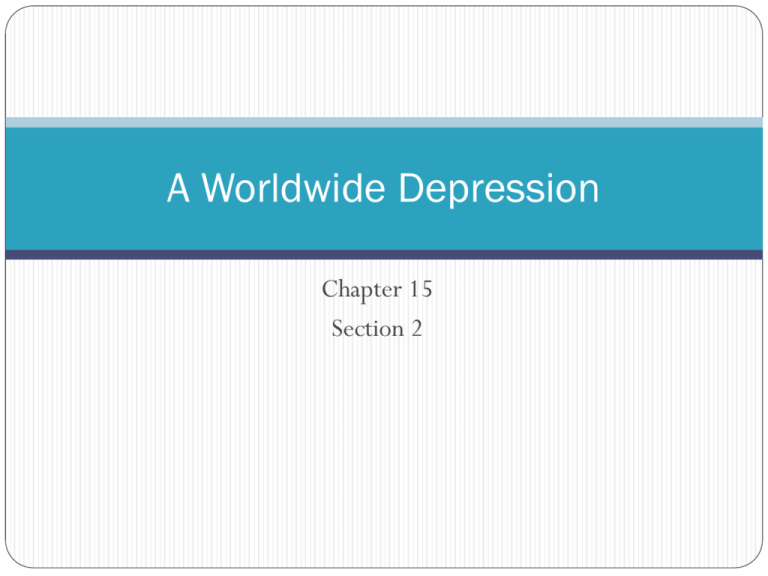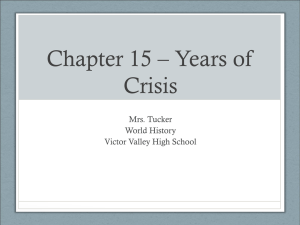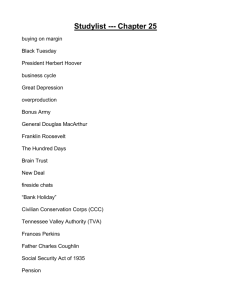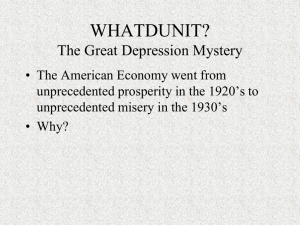Ch 15 Section 2 - A Worldwide Depression
advertisement

A Worldwide Depression Chapter 15 Section 2 Main Idea An economic depression in the United States spread throughout the world and lasted for a decade. Many social and economic programs introduced worldwide to combat the Great Depression are still operating. Introduction By the 1920s, European nations were building war-torn economies. The U.S. loaned other nations money to rebuild. Americans were certain that their economy would continue to prosper. Booming stock market. The American economy, however, had serious weaknesses that were about to be revealed. Postwar Europe World War I was extremely costly. Death ~ 8,000,000; Wounded ~ 19. 5 million Money ~ 338 billion The Great War left every major European country nearly bankrupt. Europe’s domination in world affairs also declined. Unstable New Democracies After the war new democracies were created. During the war, the last absolute rulers were overthrown. 1917 – Russia forms a new government, The Provisional Government. Hoped to establish constitutional and democratic rule. However, within months it fell to a Communist dictatorship. Coalition Government Europeans had little experience with a representative government. In the past, the kings and queens ruled the nations. Some countries, like France, had parliaments before WWI. Problem – too many political parties The winning party could not gain enough support to rule effectively. If no single party won, then several parties formed an alliance – coalition government. Seldom lasted long. Coalitions Because coalitions rarely lasted long it was difficult for democratic countries to develop strong leadership and focus on long-term goals. Therefore, many voters were willing to sacrifice democratic government for authoritarian leadership. The Weimar Republic 1919 - Germany’s new government – Weimar Republic. Weaknesses 1. Germany lacked a strong democratic tradition. 2. Several major political parties and many minor ones. 3. Millions of Germans blamed the Weimar Republic for their defeat and humiliation caused by the Versailles Treaty. Inflation Causes Crisis in Germany Germany had major economic problems. During the war, Germany did not increase its wartime taxes. To pay for the war, Germans simply printed money. What’s the problem with that? INFLATION After Germany’s defeat, the money steadily lost its value. Inflation Germans needed more and more money to buy the basic goods. 1918 – Berlin – a loaf of bread cost less than one mark. 1922 – Berlin – 160 marks. 1923 – Berlin – 200 billion marks. Attempts at Economic Stability Charles Dawes, an American banker, developed a plan that provided for a $200 million loan from American banks. This plan also set a more realistic schedule for Germany’s reparations payments. Dawes Plan helped slow inflation. By 1929, German factories were producing as much as they were before the war. Efforts at a Lasting Peace 1928 – almost every country in the world signed an agreement to “renounce war as an instrument of national policy.” Known as the Kellogg-Briand Pact. There was no way to back up the treaty. The League of Nations did not have any armed forces. The U.S. still refused to join. However, the peace agreement seemed to be a good start. Financial Collapse There were several weaknesses in the U.S. economy: Uneven distribution of wealth Overproduction by business and agriculture Many Americans were buying less By 1929 – American factories were producing about ½ of the world’s industrial goods. Uneven Distribution of Wealth There were large profits from industry. The richest 5% of the population received 33% of all income in 1929. 60% of American families earned less than $2,000 a year. Most families were too poor to buy goods that were being produced. Endless Cycle Most families were too poor to buy goods store owners cut back orders factories cut back production laid off workers families bought fewer goods factories made more cuts in production laid off more workers… Overproduction Overproduction affected American farmers, as well. New methods and machinery made it possible to grow more food. New competition from other countries. Surplus drove prices down profits decrease farmers can’t pay mortgage banks close People don’t see the signs of a crashing economy and continue to play the stock market. The Stock Market Crashes 1929 – Wall Street is the financial capital of the world. People were excited about the booming economy. Middle class people often bought stocks at margin. They pay a down payment on the stocks and borrow the rest from a stock broker. Worked great as long as stocks were rising. If they fell, how would you repay the broker? The Crash September 1929 – investors felt that stocks were unnaturally high. Sold their stocks out of fear of a decline. October 24th – by this point the lowering of stock prices had become a downward spiral. A panic resulted. Everyone was selling stocks and no one was buying. October 29, 1929 – 16 million stocks were sold. The market collapsed. The Great Depression People could not pay the money they owed on margin purchases. Stocks bought at high prices are now worthless. Unemployment rates began to rise, production, prices and wages declined. This long business slump is known as the Great Depression. The Great Depression (cont.) The stock market crash quickened the collapse of the economy. 1932 – factory production was cut in half. Thousands of businesses failed, banks closed. Around 9 million people lost all the money in their savings accounts because the banks had no money to repay them. Farmers lost their land. By 1933 – ¼ of American workers had no jobs. A Global Depression The collapse of the American economy sent shock waves around the world. American bankers demanded repayment on overseas loans. U.S. Congress placed high tariffs on import goods so that U.S. dollars would stay in the U.S. Backfired Conditions worsened. Set off a chain reaction. World wide trade dropped by 65%. Unemployment rates soared. Effects Throughout the World Due to war debts and dependence on American loans, Austria and Germany were particularly hit hard. Britain Takes Steps to Improve Its Economy Britain was hit severely by the Depression. Elected a National Government. Passed high tariffs, increased taxes and regulated currency. Lowered interest rates. Brought a slow but steady recovery. By 1937 – unemployment was cut in half. Production increased. Recovery in the United States 1932 – the first presidential election after the Depression. America elected Franklin D. Roosevelt. Sought to restore Americans’ faith in their nation. New Deal Roosevelt immediately began a program of government reform called the New Deal. Public works projects provided jobs for the unemployed. New government agencies gave financial help to businesses and farms. Welfare and relief programs. Roosevelt believed that government spending would create jobs and start a recovery. Regulations were imposed to help the stock market and the banking system. New Deal (cont.) New Deal did eventually reform the American economic system. It wasn’t until the U.S. entered WWII in 1942 when a full recovery happened. How could another war lead to economic recovery?



